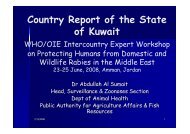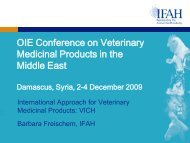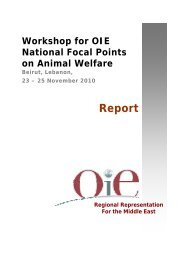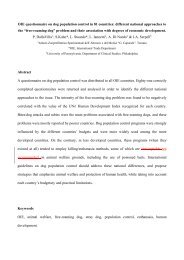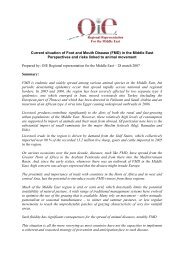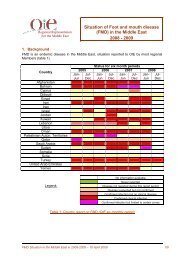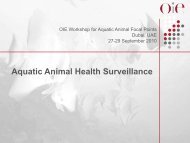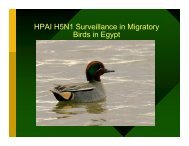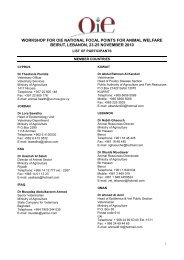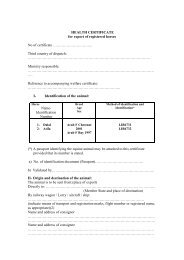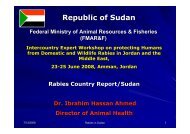A review on White Spot Disease in penaeid ... - Middle East - OIE
A review on White Spot Disease in penaeid ... - Middle East - OIE
A review on White Spot Disease in penaeid ... - Middle East - OIE
You also want an ePaper? Increase the reach of your titles
YUMPU automatically turns print PDFs into web optimized ePapers that Google loves.
Ali Khatibi Tabar D.V.MDepartment of Shrimp Aquaculture & Process<strong>in</strong>g,Mabsout & Idriss SAL, Beirut , Leban<strong>on</strong>
Nature of the WSD• <strong>White</strong> spot disease (WSD) is a highlyc<strong>on</strong>tagious viral disease of <strong>penaeid</strong>shrimp (family Penaeidae),characterized by the rapid <strong>on</strong>set ofhigh levels of mortality <strong>in</strong> farmedshrimp populati<strong>on</strong>s.• Outbreaks are preceded by cessati<strong>on</strong>of shrimp feed<strong>in</strong>g followed with<strong>in</strong> afew days by the appearance ofmoribund shrimp at the edge ofp<strong>on</strong>ds and then mass mortality.• WSD has exhibited panzootic behavior<strong>in</strong> Asia and the Americas.Pictures: M.Afshrnasab
Aetiology• The causative agent of <strong>White</strong> <strong>Spot</strong> <strong>Disease</strong> is <strong>White</strong> <strong>Spot</strong> SyndromeVirus (WSSV) which is an enveloped, double stranded DNA virus.• In the 8 th report of the Internati<strong>on</strong>al Committee <strong>on</strong> Tax<strong>on</strong>omy ofViruses (ICTV) <strong>in</strong> 2004, WSSV was assigned as the <strong>on</strong>ly member of thegenus Whispovirus with<strong>in</strong> the Nimaviridae family. Viri<strong>on</strong>s of WSSV areovoid or ellipsoid to Bacilliform <strong>in</strong> shape, have a regular symmetry, andmeasure 120–150 nm <strong>in</strong> diameter and 270–290 nm <strong>in</strong> length. Mostnotable is the thread- or flagella-like extensi<strong>on</strong> (appendage) at <strong>on</strong>e endof the viri<strong>on</strong>.WSSV particles <strong>in</strong> l<strong>on</strong>gitud<strong>in</strong>al and cross secti<strong>on</strong> <strong>in</strong> nucleus, L.vannamei
Susceptible species• All decapod crustaceans (order Decapoda), <strong>in</strong>clud<strong>in</strong>g shrimps,lobsters and crabs from mar<strong>in</strong>e, brackish or freshwaterenvir<strong>on</strong>ments, are c<strong>on</strong>sidered susceptible to <strong>in</strong>fecti<strong>on</strong>.
World Distributi<strong>on</strong>• Prior to 1992, global shrimp producti<strong>on</strong> had been<strong>in</strong>creas<strong>in</strong>g c<strong>on</strong>sistently year after year s<strong>in</strong>ce datawere first recorded <strong>in</strong> 1970. For the first time, <strong>in</strong>that year, a disease known as <strong>White</strong> <strong>Spot</strong>Syndrome began to cause devastat<strong>in</strong>g fatalities <strong>in</strong>the T’aipei Taiwanese prov<strong>in</strong>ce shrimp farms andsubsequently <strong>in</strong> the Fuzh<strong>on</strong> and Quangzhouprov<strong>in</strong>ces <strong>in</strong> Ch<strong>in</strong>a.• By 1994 the syndrome had spread by importedshrimp to southern Japan, through Thailand, <strong>in</strong>toInd<strong>on</strong>esia and as far west as the coast of India.• A year later, the disease leapt over the PacificOcean and spent the follow<strong>in</strong>g three yearsspread<strong>in</strong>g throughout small scale farms <strong>in</strong> NorthAmerica. Not until late 1998 or 1999 did thedisease beg<strong>in</strong> to ravage South America, first <strong>in</strong>Ecuador, then Peru and the rest of the Pacificshrimp farm<strong>in</strong>g countries.• In 2002, the WSD was seen <strong>in</strong> the <strong>Middle</strong> <strong>East</strong> <strong>in</strong>Iran.• In less than ten years this disease appeared andspread to global extent, creat<strong>in</strong>g by far thegreatest ec<strong>on</strong>omic damage of any of the otherdiseases like TSD and YHD.• The reas<strong>on</strong>s for this rapid spread arecomb<strong>in</strong>ati<strong>on</strong> of the strength of the disease, lackof awareness and preventi<strong>on</strong>,<strong>in</strong>ternati<strong>on</strong>alizati<strong>on</strong> of the <strong>in</strong>dustry and<strong>in</strong>creas<strong>in</strong>gly <strong>in</strong>tensive farm<strong>in</strong>g practices.
Prevalence and mortality rate• The prevalence of WSD is highly variable,from
Envir<strong>on</strong>mental stressors• <strong>Disease</strong> outbreaks may be <strong>in</strong>duced by stressors, as triggers for theexpressi<strong>on</strong> of the cl<strong>in</strong>ical disease, such as:• rapid changes <strong>in</strong> sal<strong>in</strong>ity that may act through osmotic stress.• The out break of the WSD <strong>in</strong> Iran <strong>in</strong> 2008(Sistan va Baluchestan Prov<strong>in</strong>ce)had occurred with<strong>in</strong> a week after a heavy ra<strong>in</strong><strong>in</strong>g which made a rapidchange <strong>in</strong> sal<strong>in</strong>ity.• Water temperature has a profound effect <strong>on</strong> disease expressi<strong>on</strong>, withaverage water temperatures of below ~30°C be<strong>in</strong>g c<strong>on</strong>ducive to WSDoutbreaks.• Increas<strong>in</strong>g the density of the shrimp per p<strong>on</strong>d also can act as a stressor ifthe p<strong>on</strong>d envir<strong>on</strong>mental factors are poorly managed. In most case of WSDoutbreak <strong>in</strong> Iran, poor management <strong>in</strong> the farms is believed to be the ma<strong>in</strong>stressor for occurrence of the disease.
Vectors• Vectors of WSD <strong>in</strong>clude:• rotifers,• mar<strong>in</strong>e molluscs,• polychaete worms and• n<strong>on</strong>-decapodal crustaceans <strong>in</strong>clud<strong>in</strong>g Artemia sal<strong>in</strong>a and• the copepods, as well as n<strong>on</strong>-crustacean aquatic arthropods such as sea Slaters(Isopoda) and Euphydradae <strong>in</strong>sect larvae.
Immunostimulants & vacc<strong>in</strong>e• The crustacean <strong>in</strong>nate immune system recognizes molecular patternsshared by large groups of pathogens, such as beta-glucans from fungi andlipopolysaccharides and peptidoglycans from bacteria.• Also reports have shown that beta-glucan, Vitam<strong>in</strong> C, seaweed extracts(fucoidan) and other immunostimulants may improve resistance to WSD.• Several studies have shown that resistance of prawns to WSV can beenhanced by exposure to these compounds. As their efficacy and methodsof adm<strong>in</strong>istrati<strong>on</strong> become better def<strong>in</strong>ed, immunostimulants may be usedto improve the resistance of farmed crustaceans to WSV and otherpathogens <strong>in</strong> an attempt to reduce the risk of disease outbreaks. However,any benefit they may c<strong>on</strong>fer is likely to be m<strong>in</strong>imal <strong>in</strong> adverse envir<strong>on</strong>mentsor <strong>in</strong> the absence of appropriate disease preventi<strong>on</strong> strategies.• Although recent studies of crustacean immunology suggest some capacityfor acquired immunity, but currently no c<strong>on</strong>sistently effective vacc<strong>in</strong>ati<strong>on</strong>methods have been developed.
Diagnostic Criteria• Cl<strong>in</strong>ical & gross signs• Histopathological f<strong>in</strong>d<strong>in</strong>gs• Laboratory tests
Cl<strong>in</strong>ical & gross signs• Infected shrimp display cl<strong>in</strong>ical signs such as :•• <strong>White</strong> spots embedded with<strong>in</strong> the which is not apathognomic sign of WSD exoskelet<strong>on</strong>,• anorexia displayed as empty <strong>in</strong>test<strong>in</strong>e andabdomen due to cessi<strong>on</strong> of feed<strong>in</strong>g,• lethargy,• swollen branchiostegites due to fluidaccumulati<strong>on</strong>,• dirty gills,• separated loose cuticle from underly<strong>in</strong>gepidermis,• yellowish-white and enlarged hepatopancreas,• Reddish discolorati<strong>on</strong> of the moribund shrimpand their gather<strong>in</strong>g around the edge of the p<strong>on</strong>ddur<strong>in</strong>g the day. A high mortality will happen after3-7 days up to 100 %.Above & below. <strong>White</strong> <strong>Spot</strong>s <strong>in</strong> WSD .Source: D.V.LightnerLeft.WSD <strong>in</strong>P.m<strong>on</strong>od<strong>on</strong>Source:.CawanganPenyelidikanAkuakultur &Industri
Cl<strong>in</strong>ical & Gross sign reported from Iran• Gross signs <strong>in</strong> WSD out break <strong>in</strong> 2008 <strong>in</strong> L.vannamei farms <strong>in</strong> Iran(Khuzestan prov<strong>in</strong>ce) are reported as lethargic behavior <strong>in</strong>affected animal, cessati<strong>on</strong> of feed<strong>in</strong>g, followed with<strong>in</strong> a few daysby the appearance of moribund shrimp swimm<strong>in</strong>g near thesurface at the edge of p<strong>on</strong>d with P<strong>in</strong>k to reddish-browndiscolorati<strong>on</strong> of the body and white spot of about 0.5-2 mm <strong>on</strong>the cuticle ,especially <strong>on</strong> the <strong>in</strong>ner surface of the exoskelet<strong>on</strong> ofcephalothorax and abdomen.• The cuticle could be easily separated from the underly<strong>in</strong>gepidermis (Fig.8) and the hepatopancreas had become yellowishwhitewith a swollen and fragile texture.• Cuticular deformities such as broken or withered antennae anddamage rostrum, opaque abdom<strong>in</strong>al musculature and melanisedgill were c<strong>on</strong>sistently observed.• There was 70-100% mortality <strong>in</strong> white spot disease affectedfarms with<strong>in</strong> 7-30 days after the <strong>on</strong>set of the cl<strong>in</strong>ical signs <strong>in</strong>L.vannamei <strong>in</strong> Iran but the mortality rate <strong>in</strong> P.<strong>in</strong>dicus farmsreported from Iran <strong>in</strong> 2004 and 2006, was reached to100%with<strong>in</strong> 3-7 days after <strong>on</strong>set of more or less the similar cl<strong>in</strong>icalsigns (Afsharnassab M.et al 2009).Below. Right. L.vannamei.(afsharnasab). Left. P.<strong>in</strong>dicus.(A.ghajari-IVO)Above,left and right,below. L.vannamei, Iran 2008. ,Source: M.Afshrnasab.Below left & right ,P.Indicus ,Iran 2008. Source: A.Ghajari. IVO
Mortality
Moribund Shrimp with Red Discolorati<strong>on</strong>
<strong>White</strong> spots
Opaque muscle
Histopathological f<strong>in</strong>d<strong>in</strong>gs• The histopathology of WSD <strong>in</strong> moribund shrimps collected dur<strong>in</strong>goutbreaks is dist<strong>in</strong>ctive and can be used for prelim<strong>in</strong>ary c<strong>on</strong>firmati<strong>on</strong>of an <strong>in</strong>itial diagnosis. However, additi<strong>on</strong>al tests such as PCR, <strong>in</strong> situDNA hybridisati<strong>on</strong>, Bioassy, transmissi<strong>on</strong> electr<strong>on</strong> microscopy arerequired for f<strong>in</strong>al c<strong>on</strong>firmati<strong>on</strong> (<strong>OIE</strong> manual of aquatic 2009).• The major targets of WSSV <strong>in</strong>fecti<strong>on</strong> are tissues of ectodermal andmesodermal embry<strong>on</strong>ic orig<strong>in</strong>, especially the cuticular epitheliumand subcuticular c<strong>on</strong>nective tissues .• Although WSSV <strong>in</strong>fects the underly<strong>in</strong>g c<strong>on</strong>nective tissue <strong>in</strong> theshrimp hepatopancreas and midgut, the hepatopancreatic tubularepithelial cells of these two organs are of endodermal orig<strong>in</strong>, andthey do not become <strong>in</strong>fected.•• Moribund Shrimps with WSD, have systemic viral <strong>in</strong>fecti<strong>on</strong> lead<strong>in</strong>g t<strong>on</strong>ecrosis of tissues of ectodermal and mesodermal orig<strong>in</strong>.In the histopathological f<strong>in</strong>d<strong>in</strong>gs <strong>in</strong> WSD out break <strong>in</strong> L.vannamei ,<strong>in</strong>2008( Iran-Khuzestan prov<strong>in</strong>ce)reported by Afsharnasab M. et al.(2009), the subcuticular epithelium of stomach provides excellentview of Cowdry type A <strong>in</strong>clusi<strong>on</strong> bodies characterized by marg<strong>in</strong>atedchromat<strong>in</strong> separated from nucleoplasm. (Fig. 9).In the out break ofWSD <strong>in</strong> P.<strong>in</strong>dicus farms <strong>in</strong> 2005 (Iran-Boushehr prov<strong>in</strong>ce) reported byAfsharnassab M. et al.(2006)same histological f<strong>in</strong>d<strong>in</strong>g were seen <strong>in</strong>the moribund shrimp.• Histological signs of WSSV <strong>in</strong>fecti<strong>on</strong> <strong>in</strong>clude enlarged nuclei <strong>in</strong> tissuesof ectodermal and mesodermal orig<strong>in</strong> and the most c<strong>on</strong>venienttissue for diagnosis is the subcuticular epithelium.Infecti<strong>on</strong> andnecrosis are seen <strong>in</strong> cuticular epithelial cells and c<strong>on</strong>nective tissuecells of the stomach, carapace and gills.• Infecti<strong>on</strong> is also seen <strong>in</strong> the antennal gland epithelium, lymphoidorgan sheath cells, haematopoietic tissues , and <strong>in</strong> fixed phagocytesof the heart .• Infected cells typically have hypertrophied (enlarged) nucleic<strong>on</strong>ta<strong>in</strong><strong>in</strong>g a s<strong>in</strong>gle <strong>in</strong>tranuclear <strong>in</strong>clusi<strong>on</strong> that are <strong>in</strong>itially eos<strong>in</strong>ophilicand (as an artifact of fixati<strong>on</strong> <strong>in</strong> Davids<strong>on</strong>’s fixative soluti<strong>on</strong>) areseparated by a clear halo from the marg<strong>in</strong>ated chromat<strong>in</strong>. These areknown as Cowdry type A <strong>in</strong>clusi<strong>on</strong>s;• They are <strong>in</strong>tranuclear, eos<strong>in</strong>ophilic, amorphous and surrounded bya clear halo beneath the nuclear membrane but later, <strong>in</strong>clusi<strong>on</strong>sbecome lightly to deeply basophilic and fill the entirenucleus(LightnerD.V. 1996,<strong>OIE</strong> Manual of Aquatic 2009).Above. L.vannamei .Iran. The cuticular epithelium is separatedfrom the c<strong>on</strong>nective tissue and large basofilic <strong>in</strong>clusi<strong>on</strong> bodies(arrows)are centr<strong>on</strong>uclear and segregated from the membrane.With the progress of <strong>in</strong>fecti<strong>on</strong> the <strong>in</strong>clusi<strong>on</strong> bodies wereseparated by a halo 'from the marg<strong>in</strong>al chromat<strong>in</strong> .(H&E 100X)Source:M.Afsharnassab
Histopathological f<strong>in</strong>d<strong>in</strong>gsCowdry type A <strong>in</strong>clusi<strong>on</strong> bodies are <strong>in</strong>tranuclear, eos<strong>in</strong>ophilic, amorphousand surrounded by a clear halo beneath the nuclear membrane but later,<strong>in</strong>clusi<strong>on</strong>s become lightly to deeply basophilic and fill the entirenucleus(LightnerD.V. 1996,<strong>OIE</strong> Manual of Aquatic 2009).Left. IntranuclearIBs characteristicof WSSV<strong>in</strong>fecti<strong>on</strong>(arrow)<strong>in</strong>the haemapoeitictissue cells ofL.vannamei <strong>in</strong> Iranshow<strong>in</strong>g signs ofWSSV(H&E 100X).Source:M.Afsharnasab.Above. Intranuclear IBs characteristic of WSSV <strong>in</strong>fecti<strong>on</strong>(arrow)<strong>in</strong> thegill tissue cells of L.vannamei <strong>in</strong> Iran show<strong>in</strong>g signs of WSSV(H&E 100X).Source: M.Afsharnasab.Left. Intranuclear IBscharacteristic ofWSSV<strong>in</strong>fecti<strong>on</strong>(arrow)<strong>in</strong>the heart tissue cellsof L.vannamei <strong>in</strong> Iranshow<strong>in</strong>g signs ofWSSV(H&E 100X).Source:M.Afsharnasab.**Left.Penaeus vannamei.Hypertrophied nucleiwith<strong>in</strong> sub-cuticularepithelium. Notegranular eos<strong>in</strong>ophillicsta<strong>in</strong><strong>in</strong>g (*) with<strong>in</strong> somenuclei and densehaemotoxyl<strong>in</strong>sta<strong>in</strong><strong>in</strong>g <strong>in</strong> others(arrows). H&E sta<strong>in</strong>.Scale = 10μm.And (below left)Penaeus vannamei.WSSV particlesdevelop<strong>in</strong>g with<strong>in</strong>nucleus of <strong>in</strong>fectedcuticular epithelial cell.TEM. Scale = 1μm.Source:EuropeanCommunity ReferenceLaboratory forCrustacean <strong>Disease</strong>sleaflet 2008
Histopathological f<strong>in</strong>d<strong>in</strong>gs12Histological secti<strong>on</strong>s(900x) of the stomachsof blue shrimp(P. stylirostris, Fig 1)and white shrimp(P. vannamei, Fig 2)experimentally<strong>in</strong>fected with WSD.Both species displaysevere<strong>in</strong>fecti<strong>on</strong>s by WSD,with classic WSD<strong>in</strong>tranuclear <strong>in</strong>clusi<strong>on</strong>bodies (arrows)Source: DV Lightner345Secti<strong>on</strong>s of varioustissues from aWSD-<strong>in</strong>fectedjuvenile whiteshrimp reacted by<strong>in</strong> situ hybridisati<strong>on</strong>with a DIG-labelledDNA probe to thevirus. The probe hasreacted str<strong>on</strong>glywith <strong>in</strong>tranuclear<strong>in</strong>clusi<strong>on</strong> bodiesc<strong>on</strong>ta<strong>in</strong><strong>in</strong>g WSD <strong>in</strong>the various tissues ofthis shrimp, <strong>in</strong>clud<strong>in</strong>gthe cuticularepithelium of thestomach (Fig 3,900x), the cuticularepithelium andc<strong>on</strong>nective tissues ofthe carapace (Fig 4,900x), and epithelialcells <strong>in</strong> the antennalgland (Fig 5, 450x)Source: DV Lightner
Laboratory tests & procedures• Laboratory procedures should comply with the Manual of Diagnostic Tests for Aquatic Animals (the <strong>OIE</strong> AquaticManual 2009). The recommended m<strong>in</strong>imum numbers of specimens to collect for diagnosis are 100 for the larval stages ofmost crustaceans; 50 for the postlarval stages; and 10 for juveniles and adults, with preference for <strong>in</strong>dividuals with signsand/or gross lesi<strong>on</strong>s.• There are two situati<strong>on</strong>s <strong>in</strong> which WSSV <strong>in</strong>fecti<strong>on</strong> requires detecti<strong>on</strong>: For c<strong>on</strong>firmati<strong>on</strong> of suspect cl<strong>in</strong>ical WSD and In Targetedsurveillance (screen<strong>in</strong>g) to establish the <strong>in</strong>fecti<strong>on</strong> status of asymptomatic populati<strong>on</strong>s.• -C<strong>on</strong>firmati<strong>on</strong> of suspect cl<strong>in</strong>ical WSD• For c<strong>on</strong>firmati<strong>on</strong> of a suspected outbreak, animals that are representative of those show<strong>in</strong>g cl<strong>in</strong>ical and/or gross signs shouldbe sampled. Whole animals, haemolymph, gills, stomach, abdom<strong>in</strong>al muscles and pleopods provide suitable specimens forexam<strong>in</strong>ati<strong>on</strong>. Although dead animals can sometimes provide useful diagnostic <strong>in</strong>formati<strong>on</strong>, they are often unsuitable forexam<strong>in</strong>ati<strong>on</strong> because of the rapid <strong>on</strong>set of postmortem changes.• There is a higher probability of detect<strong>in</strong>g the virus <strong>in</strong> crabs than <strong>in</strong> shrimp. The best life stages of crustaceans for detecti<strong>on</strong>are late PL stages, juveniles and adults. Probability of detecti<strong>on</strong> can be <strong>in</strong>creased by exposure to stressful c<strong>on</strong>diti<strong>on</strong>s (e.g. eyestalkablati<strong>on</strong>, spawn<strong>in</strong>g, moult<strong>in</strong>g, changes <strong>in</strong> sal<strong>in</strong>ity, temperature or pH, and dur<strong>in</strong>g plankt<strong>on</strong> blooms)( <strong>OIE</strong> Manual ofAquatic 2009).• -Targeted SurveillanceFor keep<strong>in</strong>g apparently healthy populati<strong>on</strong>s under surveillance, the number of animals to be tested will depend <strong>on</strong> therequired level of c<strong>on</strong>fidence <strong>in</strong> the f<strong>in</strong>d<strong>in</strong>gs. Whole larvae, postlarvae and juvenile animals, as well as haemolymph, gills orpleopods from juveniles to broodstock, provide suitable specimens for exam<strong>in</strong>ati<strong>on</strong>.• Two-Step PCR is the preferred test and will be follow-up bioassay to c<strong>on</strong>firm the presence of viable virus <strong>in</strong> PCR-positivesamples if required.• Two-step PCR and sequenc<strong>in</strong>g are the recommended methods as well for declar<strong>in</strong>g freedom of acountry/z<strong>on</strong>e/compartment, <strong>on</strong>ly for juveniles and adults and possibly PLs. For such purpose, Two-step PCR negative resultsare required. Where a two-step PCR positive result cannot be c<strong>on</strong>firmed by sequenc<strong>in</strong>g, this also counts as a negativeresult.(<strong>OIE</strong> Manual of Aquatic 2009).• In n<strong>on</strong>-destructive screen<strong>in</strong>g by PCR, it is recommended by <strong>OIE</strong> aquatic manual to submit (a small piece of) gill, (a smallaliquot of) haemolymph or (a small piece of) pleopod. There is also some evidence to suggest that an ablated eyestalk wouldbe a good alternative, provided that the compound eye is removed prior to submissi<strong>on</strong> s<strong>in</strong>ce it may c<strong>on</strong>ta<strong>in</strong> a PCR <strong>in</strong>hibitor.• Def<strong>in</strong>iti<strong>on</strong> of a suspect case of WSD, accord<strong>in</strong>g to <strong>OIE</strong> aquatic manual, for juvenile and adult shrimp is gross signs of WSD, forthe shrimp at any life stage (larva to adult) is mortality and for shrimp and crab at any life stage (larva to adult) arehypertrophied nuclei <strong>in</strong> squash preparati<strong>on</strong>s of gill and/or cuticular epithelium; unusual aggregates <strong>in</strong> haemolymph by darkfieldmicroscopy; <strong>in</strong>clusi<strong>on</strong> bodies <strong>in</strong> histological secti<strong>on</strong>s <strong>in</strong> target tissues. Suspect cases should first be checked by PCR. If <strong>in</strong>a previously WSSV-free country/z<strong>on</strong>e/compartment, PCR results are positive, then, they should be c<strong>on</strong>firmed by sequenc<strong>in</strong>g.Histopathology, probes and electr<strong>on</strong> microscopy also can be used to c<strong>on</strong>firm the case.
Laboratory methods• Diagnostic Laboratory methods that currently are be<strong>in</strong>g used are:• 1-Rapid methods of presumptive diagnosis ,with two approach available, a) Prepar<strong>in</strong>g Wet mounts,Dem<strong>on</strong>strate the hypertrophied nuclei <strong>in</strong> squash preparati<strong>on</strong>s of the gills and/or cuticular epithelium, whichcan be sta<strong>in</strong>ed or unsta<strong>in</strong>ed, b)Prepar<strong>in</strong>g Smears, Dem<strong>on</strong>strate WSSV aggregates <strong>in</strong> unsta<strong>in</strong>ed smearpreparati<strong>on</strong>s of haemolymph by dark-field microscopy. This is the simplest of the microscopic techniques andis recommended for people with limited expertise <strong>in</strong> WSSV. The aggregates appear as small reflective spots of0.5 μm <strong>in</strong> diameter .• 2- Histopathology,with prepar<strong>in</strong>g fixed secti<strong>on</strong>s that dem<strong>on</strong>strates pathognom<strong>on</strong>ic <strong>in</strong>clusi<strong>on</strong> bodies <strong>in</strong> targettissues.The secti<strong>on</strong>s must be exam<strong>in</strong>ed by light microscopy for the presence of moderate to large numbers ofhypertrophied nuclei with eos<strong>in</strong>ophilic to basophilic central <strong>in</strong>clusi<strong>on</strong>s surrounded by marg<strong>in</strong>ated chromat<strong>in</strong> <strong>in</strong>tissues of ectodermal and mesodermal orig<strong>in</strong>. The best tissues for exam<strong>in</strong>ati<strong>on</strong> are the subcuticular tissues ofthe stomach, cephalothorax or gill .• 3- In situ DNA hybridizati<strong>on</strong>, by us<strong>in</strong>g WSSV-specific DNA probes with histological secti<strong>on</strong>s to dem<strong>on</strong>strate thepresence of WSSV nuclei acid <strong>in</strong> <strong>in</strong>fected cells.• 4-Bioassay method, that will c<strong>on</strong>firm the presence of a pathogenic virus, but does not identify the specificvirus. Therefore, bioassay must be used <strong>in</strong> c<strong>on</strong>juncti<strong>on</strong> with laboratory tests to c<strong>on</strong>firm the identity of thevirus. If SPF shrimp are available, the bioassay method is based <strong>on</strong> Nunan L.M.et al. (1998) and Durand S.V. etal. (2000), is suitable for WSSV diagnosis recommended by <strong>OIE</strong> aquatic manual.In situ DNA hybridizati<strong>on</strong>,Source: D.V.lightner• 5- Transmissi<strong>on</strong> Electr<strong>on</strong> Microscopy(TEM). Dem<strong>on</strong>strates the virus <strong>in</strong> tissue secti<strong>on</strong>s or <strong>in</strong> semi-purifiednegatively sta<strong>in</strong>ed virus preparati<strong>on</strong>s (e.g.from haemolymph).• 6- Antibody-based assays,There are various immunological assays <strong>in</strong>clud<strong>in</strong>g western blot analysis, immunodotassay, <strong>in</strong>direct fluorescent antibody test (IFAT), immunohistochemistry (IHC) or enzyme l<strong>in</strong>ked immunosorbentassay (ELISA) to detect WSSV by us<strong>in</strong>g both polycl<strong>on</strong>al and m<strong>on</strong>ocl<strong>on</strong>al antibodies raised aga<strong>in</strong>st either thevirus or a recomb<strong>in</strong>ant viral structural prote<strong>in</strong>. Antibody-based methods can be fast, c<strong>on</strong>venient andapplicable to field use, but as they have <strong>on</strong>ly about the same sensitivity as 1-step PCR, they are recommended<strong>on</strong>ly to c<strong>on</strong>firm acute WSD.• 7- Polymerase Cha<strong>in</strong> Reacti<strong>on</strong> test (PCR) ,Two –step PCR test is the preferred recommended test by <strong>OIE</strong> aquaticmanual. The protocol described <strong>in</strong> <strong>OIE</strong> aquatic manual is from Lo C.F. et al. (1997), and is recommended for allsituati<strong>on</strong>s where WSSV diagnosis is required. A positive result <strong>in</strong> the first step of this standard protocol impliesa serious WSSV <strong>in</strong>fecti<strong>on</strong>, whereas, when a positive result is obta<strong>in</strong>ed <strong>in</strong> the sec<strong>on</strong>d amplificati<strong>on</strong> step <strong>on</strong>ly, alatent or carrier-state <strong>in</strong>fecti<strong>on</strong> is <strong>in</strong>dicated. Alternative assays have also been described, but are notrecommended unless they have first been compared with the protocol described there.• Many countries have developed the PCR test by design<strong>in</strong>g primers from the virus stra<strong>in</strong> <strong>in</strong> their country <strong>in</strong>order to prepare a more specific diagnostic kits for detecti<strong>on</strong> of WSSV. Iranians as well, have designed such kitby us<strong>in</strong>g a designated primer orig<strong>in</strong>ally from VP24 prote<strong>in</strong> of the virus <strong>in</strong> the diseased shrimp.•• PCR commercial kits are available for WSSV diagnosis and are acceptable provided they have been validated asfit for such purpose. Please c<strong>on</strong>sult the <strong>OIE</strong> Register for kits that have been certified by the <strong>OIE</strong>(http://www.oie.<strong>in</strong>t/vcda/eng/en_vcda_registre.htm).• 8- DNA Sequenc<strong>in</strong>g of PCR products, For c<strong>on</strong>firmati<strong>on</strong> of suspected new hosts of WSSV, the DNA fragmentamplified from the two-step nested diagnostic PCR should be sequenced. The cl<strong>on</strong><strong>in</strong>g and sequenc<strong>in</strong>gprotocols described <strong>in</strong> <strong>OIE</strong> aquatic manual are accord<strong>in</strong>g to Clayd<strong>on</strong> K. et al. (2004).Picture: M. Afsharnasab, Outbreak <strong>in</strong> Khuzestan prov<strong>in</strong>ce, Iran, 2008.The designated primer, orig<strong>in</strong>ally by VP24 with 414 bp from WSSV is used <strong>in</strong>the PCR test.
Comparis<strong>on</strong> of WSSV targeted surveillance and diagnostic methodsMethodTrageted surveillanceLarvae PLs Juveniles AdultsPresumptivediagnosisC<strong>on</strong>firmatorydiagnosisGross signs D D C C C DBioassay D D D D C BDirect LM D D C C C CHistopathology D C C C A ATransmissi<strong>on</strong> EM D D D D D AAntibody-basedassaysD D C C A BDNA probes <strong>in</strong> situ D D C C A APCR D B A A A ASequence D D D D D APLs = post larvae; LM = light microscopy; EM = electr<strong>on</strong> microscopy; PCR = polymerase cha<strong>in</strong> reacti<strong>on</strong>.A = the method is the recommended method for reas<strong>on</strong>s of availability, utility, and diagnostic specificity and sensitivity;B = the method is a standard method with good diagnostic sensitivity and specificity;C = the method has applicati<strong>on</strong> <strong>in</strong> some situati<strong>on</strong>s, but cost, accuracy, or other factors severely limits its applicati<strong>on</strong>;D = the method is presently not recommended for this purpose.Source: modified from <strong>OIE</strong> Aquatic Manual 2009
PCR result of assess<strong>in</strong>g the prevalence of WSD(outbreak 2005)<strong>in</strong> different aquaculture z<strong>on</strong>es of Boushehr prov<strong>in</strong>ce,<strong>in</strong> Iran.Results from Nested PCR of WSSV detecti<strong>on</strong> <strong>in</strong> different acuaculture z<strong>on</strong>es of Boushehrprov<strong>in</strong>ce,Iran,2005(M = marker, 1,2,3,4,5,6,8,9.10,11 positive samples different aquaculture z<strong>on</strong>es. 7negative sample (Water for c<strong>on</strong>trol) , 12, 13 and14 c<strong>on</strong>trol standard <strong>in</strong> high, moderate andchr<strong>on</strong>ic level).Source: Dashtyarnasab & Yeganeh.
Differential Diagnosis• The cl<strong>in</strong>ical gross signs observed dur<strong>in</strong>g outbreaks of WSD are n<strong>on</strong>specific. Therefore, the diagnostician must c<strong>on</strong>sider anyrapidly <strong>in</strong>creas<strong>in</strong>g mortality <strong>in</strong> a shrimp p<strong>on</strong>d as potentially be<strong>in</strong>g due to <strong>in</strong>fecti<strong>on</strong> by viruses, <strong>in</strong>clud<strong>in</strong>g WSSV. To aid <strong>in</strong>differential diagnosis, key features of the 4 major viral diseases known to be capable of caus<strong>in</strong>g massive mortalities <strong>in</strong> <strong>on</strong>e ormore of the <strong>penaeid</strong> species farms are compared <strong>in</strong> Table 5.• Taura syndrome virus (TSV) has caused serious commercial losses <strong>on</strong>ly <strong>in</strong> juvenile to adult L. vannamei (Pacific white shrimp)<strong>in</strong> the Lat<strong>in</strong> Americas farms and more recently <strong>in</strong> Asia. Infectious hypodermal and haematopoietic necrosis (IHHN), caused byIHHN virus (IHHNV), causes severe mortalities <strong>in</strong> farmed, and possibly wild, P.stylirostris (Pacific blue shrimp).• Although P. m<strong>on</strong>od<strong>on</strong> and P. jap<strong>on</strong>icus are susceptible to <strong>in</strong>fecti<strong>on</strong>, there are no reports of IHHNV-related disease <strong>in</strong> thesespecies. Massive mortalities <strong>in</strong> <strong>in</strong>dividual shrimp p<strong>on</strong>ds unrelated to disease events are rare, but can follow equipment failureor serious management errors (e.g. miscalculat<strong>in</strong>g chemical c<strong>on</strong>centrati<strong>on</strong>s) as well as exposure to envir<strong>on</strong>mental tox<strong>in</strong>s suchas pesticides. However, such causes can usually be identified.• Causes of more moderate mortalities, such as poor p<strong>on</strong>d envir<strong>on</strong>mental c<strong>on</strong>diti<strong>on</strong>s and subsequent bacterial <strong>in</strong>fecti<strong>on</strong>s <strong>in</strong> theshrimps, can usually be identified by <strong>in</strong>specti<strong>on</strong> of p<strong>on</strong>d records and exam<strong>in</strong>ati<strong>on</strong> of representative moribund animals, us<strong>in</strong>ghistopathology and microbiology if necessary. Of particular note is the descripti<strong>on</strong> of bacterial white spot syndrome <strong>in</strong> farmedshrimps, <strong>in</strong> which white spots macroscopically resembl<strong>in</strong>g those <strong>in</strong>duced by WSSV are visible <strong>in</strong> the cuticle.• Exposure to high alkal<strong>in</strong>ity has also been associated with formati<strong>on</strong> of white spots unrelated to WSSV <strong>in</strong>fecti<strong>on</strong> or bacterialcol<strong>on</strong>izati<strong>on</strong>. Neither of these n<strong>on</strong> viral white spot c<strong>on</strong>diti<strong>on</strong>s is associated with significant mortalities <strong>in</strong> affected shrimps.• In summary, a provisi<strong>on</strong>al diagnosis of WSD is justified <strong>in</strong> the case of a disease outbreak <strong>in</strong> farmed shrimps characterizedby high and rapid mortalities, white spots and/or red body discolourati<strong>on</strong> <strong>on</strong> moribund animals, and dem<strong>on</strong>strati<strong>on</strong> us<strong>in</strong>ghistopathology of eos<strong>in</strong>ophilic to basophilic <strong>in</strong>tranuclear <strong>in</strong>clusi<strong>on</strong>s <strong>in</strong> subcuticular epithelial cells. PCR and other tests canbe used to c<strong>on</strong>firm the diagnosis and rule out other possible aetiologies.
Differential diagnosis of virus-<strong>in</strong>duced mortalities that may occur<strong>in</strong> 4 major viral disease <strong>in</strong> Penaeid farms<strong>White</strong> spot disease(<strong>in</strong> allfarmed species)IHHND(<strong>in</strong> L.vannameiand P.stylirostris)Taura Syndrome(<strong>in</strong>L.vannamei)Yellow Head disease(<strong>in</strong>P.m<strong>on</strong>od<strong>on</strong>)Stage of grow out All All Usually 2–6 wkspost stock<strong>in</strong>gUsually 7-10 wks post stock<strong>in</strong>gMortalityHigh, rapidlyIncreas<strong>in</strong>g, to100% with<strong>in</strong> afew days <strong>in</strong> acute phaseHigh, rapidly <strong>in</strong>creas<strong>in</strong>g <strong>in</strong>P.stylirostris with<strong>in</strong> a few days,but <strong>in</strong> L.vannamei is as reductedgrowth and defectsModerate <strong>in</strong> theperacute andacute phasesHigh, rapidly <strong>in</strong>creas<strong>in</strong>g to100% with<strong>in</strong> a few daysExternal appearanceUsually whitespots embedded<strong>in</strong> cuticle of the carapace andbody or reddiscolourati<strong>on</strong> <strong>in</strong> body<strong>White</strong> spot <strong>on</strong>ly <strong>in</strong> the 3 to 6segment of the bodyAcute phase:general reddiscolorati<strong>on</strong>,especially tailfanOften yellowish cephalotoraxand general pale discolorati<strong>on</strong>Organs show<strong>in</strong>g virus<strong>in</strong>ducednecrosisSubcuticularepithelium,c<strong>on</strong>nectivetissue, gills,lymphoid organGills, lymphoid organ,epidermis and hypodermis,gangli<strong>on</strong>, c<strong>on</strong>nective tissue,<strong>in</strong>test<strong>in</strong>e, nervesSubcuticularepithelium,c<strong>on</strong>nectivetissue, gillsSubcuticular epithelium, gills,lymphoid organInclusi<strong>on</strong> bodiesIntranuclear;Initially eos<strong>in</strong>ophilic(Cowdry type A)Then basophilicIntranuclear;eos<strong>in</strong>ophilic(Cowdry type A)Intracytoplasmic;<strong>in</strong>itiallyeos<strong>in</strong>ophilic,then basophilicIntracytoplasmic basophilicSource: adapted from AQUAVET PLAN 2005- <strong>in</strong>formati<strong>on</strong>: Shrimp Viral disease by M.Afsharnassab 2007.IFRO
Pr<strong>in</strong>cipals of Preventi<strong>on</strong> and c<strong>on</strong>trol• Applicati<strong>on</strong> of the pr<strong>in</strong>ciples of biosecurity is normally c<strong>on</strong>sidered <strong>on</strong>ly for dangerouspathogens like WSSV, which are highly virulent, <strong>in</strong>fectious, untreatable, verticallytransmitted, have a diverse host range, and threaten the very survival of the <strong>in</strong>dustry .• The pr<strong>in</strong>ciples of biosecurity should be c<strong>on</strong>sidered to keep the pathogen not <strong>on</strong>ly out of theculture envir<strong>on</strong>ment but also out of the country and the regi<strong>on</strong>. For example, Australia hassuccessfully kept many pathogens, <strong>in</strong>clud<strong>in</strong>g WSSV, out of the country by adher<strong>in</strong>g to strictpr<strong>in</strong>ciples of biosecurity, quarant<strong>in</strong>e and health certificati<strong>on</strong>.• It is possible to prevent WSD outbreaks despite the presence of the pathogen .• Farm level of Biosecurity should be c<strong>on</strong>ducted by farmers with the help of governmentalauthorities ,but the z<strong>on</strong>e/country level of it should be carried out <strong>on</strong>ly by governmentsbefore the outbreak as preventi<strong>on</strong> or at the time of outbreak as c<strong>on</strong>trol .• Farm level Biosecurity of WSSV-Prevent<strong>in</strong>g the entry of WSSV <strong>in</strong>to Hatcheries and Farms-M<strong>on</strong>itor<strong>in</strong>g the health status of the shrimp populati<strong>on</strong>,• <strong>Disease</strong> out break and c<strong>on</strong>trol
Farm level biosecurity of WSSV• Prevent<strong>in</strong>g the entry of WSSVEpizoologically speak<strong>in</strong>g, likely pathogen carriers of WSSV, <strong>in</strong>clude:- Infected hosts (e.g. seed, broodstock, vectors, <strong>in</strong>termediate hosts, reservoir hosts),- N<strong>on</strong>-host biological carriers (e.g. birds, <strong>in</strong>sects, other predators, human be<strong>in</strong>gs) and,- Fomites (e.g. water, vehicles, buckets, shoes, nets, cloth<strong>in</strong>g).The carriers can enter the culture system through waterborne, airborne and overlandtransport routes.-Waterborne transport may <strong>in</strong>clude c<strong>on</strong>tam<strong>in</strong>ated water (e.g. p<strong>on</strong>d effluents, process<strong>in</strong>g planteffluents) and natural hosts <strong>in</strong> water.-Airborne transport (e.g. migratory birds, <strong>in</strong>sects, w<strong>in</strong>d) of pathogens is a c<strong>on</strong>cern <strong>in</strong> openfarm<strong>in</strong>g systems without cover.-Overland transport (e.g. human be<strong>in</strong>gs, animals, vehicles, farm equipment) is the mostcomm<strong>on</strong> route of <strong>in</strong>troduc<strong>in</strong>g the pathogen to the culture system.There are 2 critical po<strong>in</strong>ts for prevent<strong>in</strong>g the entry of virus:1-Hatcheris2-Farms
Prevent<strong>in</strong>g the entry of WSSV <strong>in</strong> to Hatcheries• Ma<strong>in</strong> summarized preventive measures <strong>in</strong> hatcheries are as below:-Us<strong>in</strong>g Specific Pathogen Free (SPF) and genetically improved(selective breed<strong>in</strong>g method) brood stock should be the first priorityto produce post larvae-Screen<strong>in</strong>g of virus throughout the hatchery cycle from broodstockto post larvae prior to stock <strong>in</strong> cultured p<strong>on</strong>d by two-step PCR test.-Ma<strong>in</strong>ta<strong>in</strong> the proper quarant<strong>in</strong>e under a biosecurity pr<strong>in</strong>ciplesdur<strong>in</strong>g hatchery producti<strong>on</strong>s such as: implement<strong>in</strong>g good sanitarypractices, treat<strong>in</strong>g water before use, Optimiz<strong>in</strong>g stock<strong>in</strong>g density oflarvae and ma<strong>in</strong>ta<strong>in</strong> good water quality, Treat<strong>in</strong>g hatchery effluent.
Prevent<strong>in</strong>g the entry of WSSV <strong>in</strong> to Farms• Ma<strong>in</strong> summarized preventive measures <strong>in</strong> p<strong>on</strong>d/farms are as below:-P<strong>on</strong>d preparati<strong>on</strong> to elim<strong>in</strong>ate pathogens and their carriers;-Water treatment <strong>in</strong> reservoirs to <strong>in</strong>activate the free virus and kill viruscarriers,-Water filtrati<strong>on</strong> us<strong>in</strong>g f<strong>in</strong>e filters to keep carriers out,-Closed systems to avoid c<strong>on</strong>tam<strong>in</strong>ati<strong>on</strong> from source water,-Reduced water exchange to m<strong>in</strong>imize the entry from source water andeven chang<strong>in</strong>g the water source (e.g. ground water) if required.-Prevent<strong>in</strong>g overland transportati<strong>on</strong> of virus by crab fenc<strong>in</strong>g, perimeterfenc<strong>in</strong>g, foot dips, wheel dips, and dis<strong>in</strong>fecti<strong>on</strong> programmes .• The available evidence suggests that it is possible to m<strong>in</strong>imize the entry ofWSSV to the p<strong>on</strong>d/farm if not totally prevent it.
M<strong>on</strong>itor<strong>in</strong>g the health status of the shrimp populati<strong>on</strong>• Beside the preventi<strong>on</strong>, m<strong>on</strong>itor<strong>in</strong>g the health status of shrimps at any stage of life<strong>in</strong> grow-out farms is also vital by us<strong>in</strong>g double step PCR test <strong>on</strong> the samplescollected by authorized technicians of veter<strong>in</strong>ary organizati<strong>on</strong> of each countythrough their targeted surveillance program for WSSV.• Early detecti<strong>on</strong> of the virus presence <strong>in</strong> its latent form <strong>in</strong> the populati<strong>on</strong> of a farmand subsequent c<strong>on</strong>troll<strong>in</strong>g practices can m<strong>in</strong>imize the impact of the virus and itsprobable outbreak, through tak<strong>in</strong>g <strong>in</strong>telligent decisi<strong>on</strong>s regard<strong>in</strong>g c<strong>on</strong>t<strong>in</strong>u<strong>in</strong>gfarm<strong>in</strong>g despite of the presence of pathogen by implement<strong>in</strong>g special practices ,orc<strong>on</strong>duct<strong>in</strong>g emergency harvest or even destroy<strong>in</strong>g the stock. Such approaches canprevent the p<strong>on</strong>d from becom<strong>in</strong>g a pathogen farm and a risk to other p<strong>on</strong>ds.• It should be noticed that all these biosecurity pr<strong>in</strong>ciples would <strong>on</strong>ly be correctlyimplemented if there is a high level of adopti<strong>on</strong> of Better Management Practices(BMPs) <strong>in</strong>clud<strong>in</strong>g c<strong>on</strong>cept of biosecurity am<strong>on</strong>g the farmers. The experiences ofNACA <strong>in</strong> this regard <strong>in</strong> India and Vietnam should be c<strong>on</strong>sidered seriously by theother countries. Awareness and capacity build<strong>in</strong>g of farmers <strong>on</strong> farm-levelbiosecurity c<strong>on</strong>cepts should be taken up <strong>on</strong> priority. System specific and costeffective,better management practices (BMPs) <strong>in</strong>corporat<strong>in</strong>g pr<strong>in</strong>ciples ofbiosecurity should be developed, dem<strong>on</strong>strated and validated.
<strong>Disease</strong> outbreak & its c<strong>on</strong>trol• Quick resp<strong>on</strong>se and damage c<strong>on</strong>trol should be the <strong>on</strong>ly post outbreak goal andwould prevent the spread of the disease <strong>in</strong> the farm or to other farms <strong>in</strong> thataquaculture z<strong>on</strong>e or to the natural envir<strong>on</strong>ment.• Once the outbreak occurred, the farm becomes the source of pathogen; 1)Isolati<strong>on</strong>of the farm, 2)avoid<strong>in</strong>g movements <strong>on</strong>to and 0ff the farm, 3) removal of <strong>in</strong>fectedhosts and 4)dis<strong>in</strong>fecti<strong>on</strong> programs will help c<strong>on</strong>ta<strong>in</strong> the spread of the pathogen.• Co-operative effort through governmental authorities should <strong>in</strong>clude surveillance,early warn<strong>in</strong>g, co-ord<strong>in</strong>ati<strong>on</strong> of harvest and water exchange schedules ofc<strong>on</strong>tam<strong>in</strong>ated p<strong>on</strong>ds and processor co-operati<strong>on</strong> to ensure that process<strong>in</strong>g wastesare not threats to other p<strong>on</strong>ds. In fact, a large percentage of shrimp harvest <strong>in</strong> WSDaffected areas is premature (emergency harvest) and the harvested shrimp willhave heavy loads of the virus. Transportati<strong>on</strong> and process<strong>in</strong>g of these shrimp pose abiosecurity threat.• C<strong>on</strong>troll<strong>in</strong>g and z<strong>on</strong><strong>in</strong>g for WSD may be difficult. Several surveys have shown thatshrimps can carry WSSV <strong>in</strong>fecti<strong>on</strong>s below the current level of detecti<strong>on</strong> availablewith a nested PCR test.• Under stress, such as occurs dur<strong>in</strong>g spawn<strong>in</strong>g <strong>in</strong> hatcheries, viral replicati<strong>on</strong> canoccur, with <strong>in</strong>fecti<strong>on</strong> reach<strong>in</strong>g a level where it can be detected by PCR.• Thus, <strong>in</strong> the absence of stress, latently <strong>in</strong>fected shrimp populati<strong>on</strong>s may becomeestablished and could be very difficult to detect. Reservoirs of <strong>in</strong>fecti<strong>on</strong> couldbecome established <strong>in</strong> the envir<strong>on</strong>ment <strong>in</strong> any of the species of crustacean thatare susceptible to WSSV <strong>in</strong>fecti<strong>on</strong>, and these reservoirs are unlikely to besuccessfully eradicated.
Overall Policy for C<strong>on</strong>troll<strong>in</strong>g WSD Outbreak• Each country with shrimp farm<strong>in</strong>g <strong>in</strong>dustryshould have its own tailored overall policy <strong>in</strong> thetime of WSD outbreak. Here an overall policy hasbeen briefly discussed based <strong>on</strong> Australianoverall policy <strong>in</strong> the time of outbreak. Australia isat the moment free of WSD.• In an outbreak of WSD, or if the white spot virus(WSSV) is detected, the choice of resp<strong>on</strong>se policyshould be decided by the director of fisheriesand/or the chief veter<strong>in</strong>ary officer (CVO) of thestate or territory <strong>in</strong> which the outbreak occurs,follow<strong>in</strong>g <strong>in</strong>itial epizoological <strong>in</strong>vestigati<strong>on</strong>s.• There are three possible resp<strong>on</strong>se policies to bec<strong>on</strong>sidered for WSD c<strong>on</strong>trol:• Policy 1 - Eradicati<strong>on</strong> with the aim of hav<strong>in</strong>g thecountry returns to be<strong>in</strong>g free from WSSV;• Policy 2 - C<strong>on</strong>ta<strong>in</strong>ment, c<strong>on</strong>trol and z<strong>on</strong><strong>in</strong>g of thevirus to areas with enzootic <strong>in</strong>fecti<strong>on</strong>, preventi<strong>on</strong>of further spread and protecti<strong>on</strong> of un<strong>in</strong>fectedareas; and• All these resp<strong>on</strong>se policies <strong>in</strong>volve the use of acomb<strong>in</strong>ati<strong>on</strong> of strategies, which may <strong>in</strong>clude:• - Quarant<strong>in</strong>e and movement c<strong>on</strong>trols <strong>on</strong>crustaceans and th<strong>in</strong>gs <strong>in</strong> declared areas toprevent spread of <strong>in</strong>fecti<strong>on</strong>;• - Destructi<strong>on</strong> of all cl<strong>in</strong>ically diseased or deadshrimps as so<strong>on</strong> as possible, to prevent furthervirus shedd<strong>in</strong>g;• - Dec<strong>on</strong>tam<strong>in</strong>ati<strong>on</strong> of facilities, products andth<strong>in</strong>gs to elim<strong>in</strong>ate the virus from <strong>in</strong>fected farmsand premises and to prevent spread of <strong>in</strong>fecti<strong>on</strong>;• - Surveillance to determ<strong>in</strong>e the source andextent of <strong>in</strong>fecti<strong>on</strong> and to provide proof offreedom;• - Z<strong>on</strong><strong>in</strong>g to def<strong>in</strong>e and ma<strong>in</strong>ta<strong>in</strong> <strong>in</strong>fected anddisease-free z<strong>on</strong>es; and• - Hygiene and biosecurity measures aimed atmitigat<strong>in</strong>g the <strong>on</strong>-farm effects of WSD.• Policy 3 - C<strong>on</strong>trol and mitigati<strong>on</strong> of disease if it isaccepted that the virus will rema<strong>in</strong> enzootic <strong>in</strong>the country.
Eradicati<strong>on</strong>sEradicati<strong>on</strong> may not be feasible if epizoological <strong>in</strong>vestigati<strong>on</strong>s determ<strong>in</strong>e that WSSV <strong>in</strong>fecti<strong>on</strong> is widespreadacross most or all of the shrimp aquaculture z<strong>on</strong>es, has no c<strong>on</strong>trollable source or is otherwise unable tobe c<strong>on</strong>ta<strong>in</strong>ed.Eradicati<strong>on</strong> measures <strong>in</strong>clude:• Establishment of specified areas — restricted, c<strong>on</strong>trol, free;• Quarant<strong>in</strong>e and movement c<strong>on</strong>trols or restricti<strong>on</strong>s <strong>on</strong> shrimps, other crustaceans, water andany other vectors (<strong>in</strong>clud<strong>in</strong>g materials and equipment) <strong>in</strong> declared restricted and c<strong>on</strong>trol areasto prevent the spread of <strong>in</strong>fecti<strong>on</strong>;• Destructi<strong>on</strong> and disposal of all cl<strong>in</strong>ically diseased shrimp,• On-farm process<strong>in</strong>g (for example, by cook<strong>in</strong>g) of exposed or potentially exposed, butcl<strong>in</strong>ically normal prawns to prevent the spread of <strong>in</strong>fecti<strong>on</strong>;• Dis<strong>in</strong>fecti<strong>on</strong> and safe disposal of process<strong>in</strong>g effluent and waste (cook<strong>in</strong>g water, shrimpheads and shells);• Dis<strong>in</strong>fecti<strong>on</strong> and safe disposal of p<strong>on</strong>d water and dec<strong>on</strong>tam<strong>in</strong>ati<strong>on</strong> of p<strong>on</strong>ds, facilities,products, equipment, vehicles, boats etc to elim<strong>in</strong>ate the virus from <strong>in</strong>fected premises and toprevent spread;• Use of farm perimeter barriers to prevent entry or escape of potentially <strong>in</strong>fected wildcrustaceans;• Trac<strong>in</strong>g and surveillance to determ<strong>in</strong>e the source and extent of <strong>in</strong>fecti<strong>on</strong> and to provideproof of freedom from the disease; and• A public awareness campaign to encourage cooperati<strong>on</strong> from <strong>in</strong>dustry and the community.
C<strong>on</strong>ta<strong>in</strong>ment, C<strong>on</strong>trol & Z<strong>on</strong><strong>in</strong>gSimilar to Eradicati<strong>on</strong>, the feasibility of C<strong>on</strong>ta<strong>in</strong>ment ,C<strong>on</strong>trol and Z<strong>on</strong><strong>in</strong>g will depend <strong>on</strong> farmmanagement practices, the extent to which <strong>in</strong>fecti<strong>on</strong> has already spread, and the locati<strong>on</strong>, distributi<strong>on</strong>and migratory behavior of <strong>in</strong>fected species.Measures for c<strong>on</strong>ta<strong>in</strong>ment, c<strong>on</strong>trol and z<strong>on</strong><strong>in</strong>g are similar to those for eradicati<strong>on</strong>, but will emphasizemanagement of the disease <strong>in</strong> <strong>in</strong>dividual facilities. Procedures may <strong>in</strong>clude:• Z<strong>on</strong><strong>in</strong>g to def<strong>in</strong>e <strong>in</strong>fected and disease-free areas; A successful z<strong>on</strong><strong>in</strong>g strategy will rely <strong>on</strong> movementrestricti<strong>on</strong>s <strong>on</strong> exposed or potentially exposed prawns to prevent <strong>in</strong>fecti<strong>on</strong> spread<strong>in</strong>g to un<strong>in</strong>fected z<strong>on</strong>es.• Quarant<strong>in</strong>e and movement c<strong>on</strong>trols or restricti<strong>on</strong>s <strong>on</strong> shrimps, water and any other vectors (<strong>in</strong>clud<strong>in</strong>gmaterials and equipment) with<strong>in</strong> the <strong>in</strong>fected z<strong>on</strong>e and to free z<strong>on</strong>es;• Eradicati<strong>on</strong> of outbreaks <strong>in</strong> the free z<strong>on</strong>e where feasible;• P<strong>on</strong>d-level surveillance, with destructi<strong>on</strong> and safe disposal of any cl<strong>in</strong>ically diseased shrimps <strong>in</strong> the<strong>in</strong>fected z<strong>on</strong>e, followed by clean-up and dis<strong>in</strong>fecti<strong>on</strong>;• Use of closed producti<strong>on</strong> systems;• WSSV test<strong>in</strong>g of broodstock and post larvae;• Emphasis <strong>on</strong> high standards of hygiene (<strong>in</strong>clud<strong>in</strong>g dry<strong>in</strong>g of p<strong>on</strong>ds before restock<strong>in</strong>g and dis<strong>in</strong>fecti<strong>on</strong> ofwater before either use or release) and biosecurity (use of crustacean-proof land barriers and water filtersand screen<strong>in</strong>g of <strong>in</strong>com<strong>in</strong>g post larvae for WSSV);• Trac<strong>in</strong>g and surveillance to determ<strong>in</strong>e the source and extent of <strong>in</strong>fecti<strong>on</strong>; and• A public awareness campaign to encourage cooperati<strong>on</strong> from <strong>in</strong>dustry and the community.-In c<strong>on</strong>ta<strong>in</strong>ment, c<strong>on</strong>trol and z<strong>on</strong><strong>in</strong>g strategy, grow-out of exposed or potentially exposed, but cl<strong>in</strong>icallynormal shrimps will be a standard practice with<strong>in</strong> <strong>in</strong>fected z<strong>on</strong>es. The likelihood of cl<strong>in</strong>ical disease will bem<strong>in</strong>imized through appropriate farm management practices. Spread of the disease will be preventedthrough farms ma<strong>in</strong>ta<strong>in</strong><strong>in</strong>g a high level of hygiene and biosecurity.
C<strong>on</strong>trol & Mitigati<strong>on</strong>If <strong>in</strong>fecti<strong>on</strong> is widespread, and there is evidence of widespread <strong>in</strong>fecti<strong>on</strong> <strong>in</strong> wild broodstockpopulati<strong>on</strong>s(<strong>on</strong> those countries that rely <strong>on</strong> wild broodstock like Australia), C<strong>on</strong>trol and Mitigati<strong>on</strong> ofthe disease <strong>in</strong> an <strong>in</strong>dustry-based program tailored for each country farm<strong>in</strong>g specificati<strong>on</strong> ,is likely tobe the most appropriate opti<strong>on</strong>. In a c<strong>on</strong>trol and mitigati<strong>on</strong> strategy, it will be the resp<strong>on</strong>sibilityma<strong>in</strong>ly of <strong>in</strong>dividual producers to manage the disease <strong>in</strong> their facilities us<strong>in</strong>g recommendedmeasures by the resp<strong>on</strong>sible authorities to reduce the likelihood and severity of outbreaks.Producers may be encouraged to adopt current best practice through provisi<strong>on</strong> of enterprise-levelstandard operat<strong>in</strong>g procedures and quality assurance programs, lead<strong>in</strong>g to the eventualdevelopment of an accreditati<strong>on</strong> scheme.Measures for c<strong>on</strong>trol and mitigati<strong>on</strong> <strong>in</strong>clude:• P<strong>on</strong>d-level surveillance, with destructi<strong>on</strong> and safe disposal of all cl<strong>in</strong>ically diseased shrimpsfollowed by clean-up and dis<strong>in</strong>fecti<strong>on</strong> of affected p<strong>on</strong>ds;• Use of closed or partial recirculati<strong>on</strong> producti<strong>on</strong> systems, as appropriate;• WSSV test<strong>in</strong>g of broodstock and post larvae;• Emphasis <strong>on</strong> high standards of hygiene (<strong>in</strong>clud<strong>in</strong>g dry<strong>in</strong>g of p<strong>on</strong>ds before restock<strong>in</strong>g anddis<strong>in</strong>fecti<strong>on</strong> of water before use or release) and biosecurity (<strong>in</strong>clud<strong>in</strong>g cover<strong>in</strong>g the p<strong>on</strong>ds by net orsimilar to avoid birds’ access , the use of crustacean-proof land barriers and water filters ); and• Best-practice p<strong>on</strong>d management methods to m<strong>in</strong>imize stress and hence the risk of an outbreakdur<strong>in</strong>g grow-out of covertly <strong>in</strong>fected stock.Dur<strong>in</strong>g grow-out, these shrimps must be treated and handled as <strong>in</strong>fected populati<strong>on</strong>s. Restricti<strong>on</strong>s<strong>on</strong> movements of prawns, people, vehicles and boats, and <strong>on</strong> market access for products, may benecessary to protect WSSV-free facilities or z<strong>on</strong>es.
Preventi<strong>on</strong> and C<strong>on</strong>trol <strong>in</strong> Iran• Iran, with records of WSD occurrences <strong>in</strong> the pastten years seems to have implemented (accord<strong>in</strong>gto aforementi<strong>on</strong>ed overall policy) k<strong>in</strong>d of ac<strong>on</strong>ta<strong>in</strong>ment, c<strong>on</strong>trol and z<strong>on</strong><strong>in</strong>g policy, tailoredto its shrimp farms’ specificati<strong>on</strong> which is anopen semi <strong>in</strong>tensive farm<strong>in</strong>g system, located <strong>in</strong>different aquaculture z<strong>on</strong>es <strong>in</strong> its 4 coastalprov<strong>in</strong>ces <strong>in</strong> Northern coast l<strong>in</strong>e of Persian Gulfand Oman Sea.• Shar<strong>in</strong>g the experience of Iranians <strong>in</strong> severalchallenges with WSD, for the countries <strong>in</strong> theregi<strong>on</strong> who has shrimp aquaculture z<strong>on</strong>es orplann<strong>in</strong>g to have, can be beneficial due to thesimilarity of the climate and culture envir<strong>on</strong>mentand the fact that with presence of the WSSV <strong>in</strong>the northern shores of the Persian Gulf andOman Sea, the probability of spread<strong>in</strong>g of thevirus through vectors especially those withmigratory behaviors, to other parts of the regi<strong>on</strong>is very high.• The resp<strong>on</strong>sible governmental authority <strong>in</strong> Iran <strong>in</strong>this regard is” Iran Veter<strong>in</strong>ary Organizati<strong>on</strong> (IVO)”that has prepared a code of practice (RefNo.1388/44/01) (IVO official web sitewww.ivo.org.ir) <strong>in</strong> associati<strong>on</strong> of the IranianFisheries Organizati<strong>on</strong> (IFO) to be implemented <strong>in</strong>WSD outbreaks, valid at the time of writ<strong>in</strong>g thisarticle.• The policy is based <strong>on</strong> preventi<strong>on</strong> of the diseaseaccord<strong>in</strong>g to pr<strong>in</strong>ciples of biosecurity with specialattenti<strong>on</strong> <strong>on</strong> the importance of preventi<strong>on</strong> ofWSSV spread and management of the diseaseoccurrence <strong>in</strong> order to m<strong>in</strong>imize its impacts. Inparallel to this, IVO has <strong>in</strong>sisted <strong>on</strong> mak<strong>in</strong>greservoir p<strong>on</strong>d as the ma<strong>in</strong> preventive structuralneeded part of the current open farm<strong>in</strong>g system,for treat<strong>in</strong>g the <strong>in</strong>let water, through preparati<strong>on</strong>and adopti<strong>on</strong> of BMP (best managementpractices) guidel<strong>in</strong>es <strong>in</strong> associati<strong>on</strong> of IFO, for thefarmers. Also all the future established farms areplanned to be equipped with such reservoirs as arule.Pictures : Dr. A.Ghajari-IVO
Code of Practice 1388/44/01(summarized)• 1-Acti<strong>on</strong>s required:-Quarant<strong>in</strong>e and movement c<strong>on</strong>trols or restricti<strong>on</strong>s <strong>on</strong> shrimps, water and any other vectors(<strong>in</strong>clud<strong>in</strong>g materials and equipment) with<strong>in</strong> the <strong>in</strong>fected z<strong>on</strong>e and to free z<strong>on</strong>es must beimplemented by the resident IVO technicians. The details of the any permitted movement mustbe recorded.-All the other farms <strong>in</strong> the <strong>in</strong>fected z<strong>on</strong>e must be under the surveillance and <strong>in</strong> case ofreport<strong>in</strong>g any mortality or cl<strong>in</strong>ical signs; detecti<strong>on</strong> for the causative agent must be carried outto def<strong>in</strong>e the nature of the problem.Instructi<strong>on</strong>s for manag<strong>in</strong>g the diseased farm(s):• 1-In case of detecti<strong>on</strong> of the WSSV <strong>in</strong> the first m<strong>on</strong>th after stock<strong>in</strong>g by us<strong>in</strong>g Nested-PCR:• 1-1-Farm shows cl<strong>in</strong>ical form of WSD:• If the shrimps are lethargic or anorexic, show cl<strong>in</strong>ical signs of WSD with mortality, water <strong>in</strong>letand out let must be closed, Kill<strong>in</strong>g of the shrimp and dis<strong>in</strong>fect<strong>in</strong>g the water must be d<strong>on</strong>e byus<strong>in</strong>g 40PPM of Calcium Hypochlorite, and the carcass and the water should be discharge <strong>on</strong>lyafter 7 days, All the rema<strong>in</strong>ed decomposed shrimp as well as p<strong>on</strong>d bottom dirt or rema<strong>in</strong>ed <strong>in</strong>the filters must be collected, burned and buried with lime.• 1-2-Farm does not show any cl<strong>in</strong>ical sign of WSD:• By implement<strong>in</strong>g high level of hygiene and Biosecurity together with appropriate farmmanagement avoid<strong>in</strong>g any stressful situati<strong>on</strong> <strong>in</strong> the p<strong>on</strong>ds, the culture can be c<strong>on</strong>t<strong>in</strong>ued.
• 2- In case of detecti<strong>on</strong> of the WSSV <strong>in</strong> the sec<strong>on</strong>d m<strong>on</strong>th after stock<strong>in</strong>g by us<strong>in</strong>g Nested-PCR:• 2-1-The culture can be c<strong>on</strong>t<strong>in</strong>ued <strong>in</strong> associati<strong>on</strong> with avoid<strong>in</strong>g any stressful c<strong>on</strong>diti<strong>on</strong>s, if theshrimp do not show abnormal activity, are active, feed<strong>in</strong>g well, exhibit<strong>in</strong>g normal growth, d<strong>on</strong>ot have cl<strong>in</strong>ical signs of white spot and are not dy<strong>in</strong>g . In such cases, applicati<strong>on</strong> Iod<strong>in</strong>e10% at0.3-1 ppm (repeated applicati<strong>on</strong> at 3-4 days <strong>in</strong>terval), or formal<strong>in</strong> at 70 ppm (every day) orBKC at 1 ppm <strong>in</strong> grow-out p<strong>on</strong>ds with WSSV and the nearby p<strong>on</strong>ds is recommended. Thefuncti<strong>on</strong> of these chemicals is to prevent the horiz<strong>on</strong>tal transmissi<strong>on</strong> of the virus am<strong>on</strong>g theshrimps <strong>in</strong> the p<strong>on</strong>d.• 2-2- If the shrimp health c<strong>on</strong>diti<strong>on</strong> deteriorates, the shrimp stop feed<strong>in</strong>g, shrimp show cl<strong>in</strong>icalsigns of white spots and start dy<strong>in</strong>g, and s<strong>in</strong>gle step PCR test<strong>in</strong>g is positive, then:• In case of hav<strong>in</strong>g the farmed shrimp with appropriate size and weight for market, harvestmust be d<strong>on</strong>e maximum with<strong>in</strong> 24-48 hours after the c<strong>on</strong>firmed report of disease ,supervisedby IVO technicians accord<strong>in</strong>g to biosecurity pr<strong>in</strong>ciples , <strong>in</strong> such a ways that no dead or aliveshrimp or any aquatic creature could be released from the p<strong>on</strong>d, and dis<strong>in</strong>fecti<strong>on</strong> of the p<strong>on</strong>dwater must be d<strong>on</strong>e by us<strong>in</strong>g 40 ppm calcium hypochlorite and at least ,leave for 7 days beforedischarg<strong>in</strong>g. All the rema<strong>in</strong>ed of carcass or other materials must be collected and burned andburied with lime. The bottom of the p<strong>on</strong>d must be dis<strong>in</strong>fected by apply<strong>in</strong>g lime (1.5Mt/Ha).Transportati<strong>on</strong> and process<strong>in</strong>g of such shrimp must be d<strong>on</strong>e under full supervisi<strong>on</strong> ofthe IVO technicians.• In case that the shrimp is not at market size or the farmer does not have an <strong>in</strong>tenti<strong>on</strong> forharvest, then it should be treated as secti<strong>on</strong> 1-1 with the regard that if some live shrimp wereseen <strong>in</strong> the p<strong>on</strong>d after apply<strong>in</strong>g Calcium Hypochlorite, the p<strong>on</strong>d must be dis<strong>in</strong>fected aga<strong>in</strong> with<strong>in</strong>creased dose of 100ppm.
Code of Practice 1388/44/01(summarized)• 2- Special notes:• -Dis<strong>in</strong>fecti<strong>on</strong> of all the equipment and materials <strong>in</strong> the p<strong>on</strong>d must be d<strong>on</strong>e by spray<strong>in</strong>g water soluti<strong>on</strong> of Calcium Hypochlorite(1600ppm) or if possible the equipment can be submerged <strong>in</strong> its soluti<strong>on</strong> (40ppm) for at least 3 days.• -Dis<strong>in</strong>fecti<strong>on</strong> of vehicles especially the wheels must be d<strong>on</strong>e with spray<strong>in</strong>g water soluti<strong>on</strong> of Calcium Hypochlorite (1600ppm),• -Dis<strong>in</strong>fecti<strong>on</strong> of the workers cloth<strong>in</strong>g, shoes, boots must be d<strong>on</strong>e and it is better to use disposal gloves and foot covers <strong>in</strong> thenext operati<strong>on</strong>s.• -Dis<strong>in</strong>fecti<strong>on</strong> of the out let water channel of the farm must be d<strong>on</strong>e with Calcium Hypochlorite (40 ppm).• -Dis<strong>in</strong>fecti<strong>on</strong> of the p<strong>on</strong>d bottom must be d<strong>on</strong>e when it is still wet with lime appropriately after test<strong>in</strong>g the soil pH, and thenshould be left to be dried completely.• -The dis<strong>in</strong>fected water of the p<strong>on</strong>d must be discharged after at least 7 days, through the filters <strong>in</strong> order to m<strong>in</strong>imize the releaseof dirt particles and their associated microorganisms <strong>in</strong> the envir<strong>on</strong>ment. The filtered materials must be collected, burned andburied hygienically.• -Movement of workers, equipments, vehicles from the <strong>in</strong>fected farm to other farms is forbidden.• -Entrance of feed trucks to <strong>in</strong>fected farm is forbidden and the feed delivery must be d<strong>on</strong>e out side the <strong>in</strong>fected farm and shouldbe transported to <strong>in</strong>fected farm accord<strong>in</strong>g to all pr<strong>in</strong>ciples of hygiene and biosecurity.• -IVO technicians should have <strong>in</strong> place (for each farm) equipment and cloths etc. and it should not be taken out from <strong>in</strong>fectedfarm before end of the c<strong>on</strong>trol of the situati<strong>on</strong>.• -All the sampl<strong>in</strong>g and transportati<strong>on</strong> of the shrimp from the <strong>in</strong>fected p<strong>on</strong>d should be d<strong>on</strong>e subject to prior awareness andpermissi<strong>on</strong> of IVO.• -The presence of the birds <strong>in</strong> the p<strong>on</strong>d must be m<strong>in</strong>imize to even zero by any means, and all the moribund shrimp near theedge of the p<strong>on</strong>d must be collected regularly and burned and buried with lime.• - Even when dis<strong>in</strong>fectant is used to kill the shrimps, the p<strong>on</strong>d water and dead shrimp cannot be released so<strong>on</strong> after the deathof shrimp, because the virus is viable for a l<strong>on</strong>ger time with<strong>in</strong> the nuclei of deeper tissues of the shrimp body even after itsdeath. Thus, the dead carcass must be kept <strong>in</strong> the p<strong>on</strong>d for about 7 days to let the shrimp decay and to allow the virus tocompletely die by autolysis. Release of freshly killed shrimp <strong>in</strong>to open water will result <strong>in</strong> the spread of the disease and itspersistent <strong>in</strong> the same farm.
<strong>White</strong> <strong>Spot</strong> <strong>Disease</strong> c<strong>on</strong>trol measures <strong>in</strong> Iran dur<strong>in</strong>g July-Dec from 2005-2009Year Species * Qf M Te Gsu Tsu Qi S Sp Z Vp V T Cr Cn2005 Crustaceans A A A A A A A A2006 Crustaceans A A A A A A AWild species2007 Crustaceans A A A A A A A A A AWild species A A A2008 Crustaceans A A A A A AWild species2009 Crustaceans A A A A A A A A AA=Applied ,*= Notifiable disease ,Qf=Precauti<strong>on</strong>s at the borders ,M= M<strong>on</strong>itor<strong>in</strong>g, Te=Screen<strong>in</strong>g, GSu=Generalsurveillance, TSu=Targeted surveillance, Qi=Movement c<strong>on</strong>trol <strong>in</strong>side the country, S=Stamp<strong>in</strong>g out,Sp=Modified stamp<strong>in</strong>g out, Z=Z<strong>on</strong><strong>in</strong>g, Vp=Vacc<strong>in</strong>ati<strong>on</strong> Prohibited, V=Rout<strong>in</strong>e vacc<strong>in</strong>ati<strong>on</strong>, T=Treatment ,Cr=C<strong>on</strong>trol of wild life reservoirs, Cn=C<strong>on</strong>trol of arthropods,Source: <strong>OIE</strong> website
Discussi<strong>on</strong>Current achievements and experiences <strong>in</strong> many countries has proven that it is possible to reduce impact of WSD andimprove productivity and profitability of small-scale shrimp farms through disease c<strong>on</strong>trol programs, specially at the time thatthere is no vacc<strong>in</strong>ati<strong>on</strong> method developed aga<strong>in</strong>st the disease despite of many researches that has been carried out <strong>in</strong> thisregard.These c<strong>on</strong>trol programs should be developed and progressed by c<strong>on</strong>t<strong>in</strong>uous update of the knowledge about the diseaseand its causative agent, provid<strong>in</strong>g access to science-based disease c<strong>on</strong>trol pr<strong>in</strong>ciples as well as technical supports that enablesfarmers to adapt BMPs pr<strong>in</strong>ciples to their own circumstances, and promoti<strong>on</strong> of local self-help groups as experienced byNACA <strong>in</strong> different countries to facilitate cooperati<strong>on</strong> and communicati<strong>on</strong> of BMPs to a wider group of farmers, and tocollectively address health management problems. In order to have a successful promoti<strong>on</strong> <strong>in</strong> adopti<strong>on</strong> of biosecuritypr<strong>in</strong>ciples, the approach should be implemented with<strong>in</strong> a governmental <strong>in</strong>stituti<strong>on</strong>al framework as a nati<strong>on</strong>al program.Farm level biosecurity programs should be system specific, cost-effective based <strong>on</strong> the socio-ec<strong>on</strong>omic back ground andm<strong>in</strong>dset of the farmers, also comprehensive and applied from site selecti<strong>on</strong> stage through to harvest.In order to have <strong>in</strong>telligent decisi<strong>on</strong> mak<strong>in</strong>g and design<strong>in</strong>g preventive and post-outbreak programs, epizoological c<strong>on</strong>ceptsshould be c<strong>on</strong>sidered.Regi<strong>on</strong>al collaborati<strong>on</strong>s of countries <strong>in</strong> shar<strong>in</strong>g their experiences can lead to collective approaches for c<strong>on</strong>troll<strong>in</strong>g thedisease, m<strong>in</strong>imiz<strong>in</strong>g its impact <strong>on</strong> the farm<strong>in</strong>g <strong>in</strong>dustry and prevent<strong>in</strong>g the spread of the disease that will be a threat for theothers <strong>in</strong> the regi<strong>on</strong>.
AcknowledgementsThe author wish to thank the follow<strong>in</strong>g Gentlemen for their k<strong>in</strong>d supportand encouragement <strong>in</strong> prepar<strong>in</strong>g this <str<strong>on</strong>g>review</str<strong>on</strong>g>;• Dr. Ghazi Yehya, World Organizati<strong>on</strong> for Animal Health, Regi<strong>on</strong>al Representative for the <strong>Middle</strong><strong>East</strong>• Mr. M.Mabsout, Manag<strong>in</strong>g Director of Mabsout & Idriss SAL,• Dr. M.Afsharnassab, Director of Divisi<strong>on</strong> of Shrimp Health and <strong>Disease</strong>s, Iranian FisheriesResearch Organizati<strong>on</strong>,• Dr. A.Sepahdari, Director of Divisi<strong>on</strong> of Fresh Water Aquatic Animal Health and <strong>Disease</strong>s,Iranian Fisheries Research Organizati<strong>on</strong>,• Dr. R.Abdi, Head of the department of Aquatic Animal Health, Iran Veter<strong>in</strong>ary Organizati<strong>on</strong>,• Dr. A.Ghajari, Department of Aquatic animal Health, Iran Veter<strong>in</strong>ary Organizati<strong>on</strong>.• Dr. R.Bana Derakhshan, Deputy of Divisi<strong>on</strong> of Shrimp and other Mar<strong>in</strong>e Aquatics, Iran FisheriesOrganizati<strong>on</strong>.• Mr. M. Hekmat Shoar, Head of Shrimp Aquaculture Bureau, Aquaculture Department, IranFisheries Organizati<strong>on</strong>.• Mr. M.Jahanbani, Executive director of Nayband Gulf Aquaculture and Industry Co.
Thank You For Your Attenti<strong>on</strong> !




